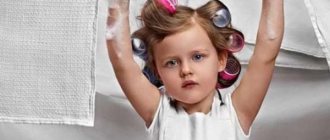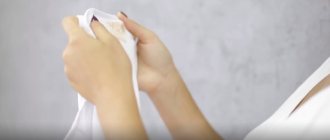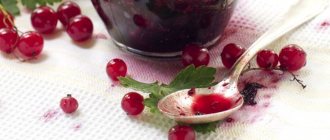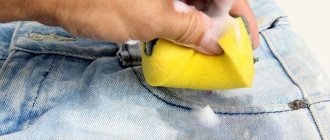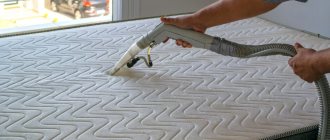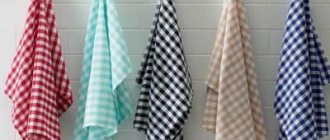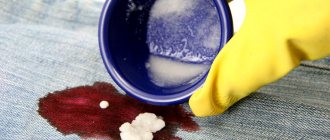During use, biological traces of human activity remain on the mattress - sweat, droplets of blood, small flakes of skin, hair, urine. Removing fresh and old stains can be difficult due to the size of the mattress. It cannot be washed in a washing machine or by hand. Here are some tips on how to remove blood stains at home using household chemicals or folk remedies that are available in every home.
Rules for removing blood from a mattress
To completely clean the product from blood stains, you need to follow several rules. They will allow you to remove blood from the surface of textiles easily and quickly. Basic Rules:
- Avoid using bleach and ammonia at the same time. When mixed, these substances release dangerous chemical vapors that negatively affect the human body. They can easily be poisoned;
- Do not treat contaminated surfaces with hot water. When the stain is exposed to high temperatures, the blood protein will coagulate, which will be difficult or completely impossible to remove;
- Treat the dirty surface with a generous amount of stain remover or home remedy, but avoid over-wetting. Excess moisture leads to the formation of mold and parasites;
- Use only white napkins or pieces of fabric to apply the product. Colored stains will not appear on the textiles, the fabric will not fade;
- when using toxic household chemicals, protect your respiratory organs with a mask and your hands with gloves;
- before starting cleaning work, test the product on an area of the mattress that is closed from outside view;
- remove traces of blood with stain removers containing protein components;
- Follow the manual instructions. Observe the proportions of the chemical substance, the time of exposure to contamination;
- After removing the dirt, dry the mattress thoroughly in the open air. You can use a vacuum cleaner or hot air hair dryer.
Features when cleaning white and colored materials
It is easier to clean blood from a white mattress than from a colored one.
This is due to the characteristics of the impregnations that are used in the manufacture of such products. When cleaning white materials, aggressive agents can be used. After this procedure, the lightened spots remain invisible.
Cleaning products for non-ferrous materials should be selected with care. Aggressive substances (in particular, stain removers) leave behind bleached stains that cannot be removed. Therefore, before starting the procedure, you need to test each selected product on an inconspicuous area.
Also, when cleaning mattresses from blood, it is necessary to take into account the manufacturer’s recommendations.
Preparatory stage
Before performing the cleansing procedure, wet the blood with cool water. The protein components of the blood will become wet and will be easier to remove.
Attention! Apply cool water carefully and do not rub or smudge marks. Move the napkin around the dirt. This will help avoid divorces and increasing boundaries.
You can remove excess liquid with a dry cloth or towel. Repeat the procedure several times. Recent period blood on the mattress may disappear completely. Old ones will require additional intervention with household chemicals.
Removing stains with household chemicals
Household chemicals can be used both after and instead of household cleaning products.
Safe stain removal
To remove blood stains and not damage the mattress, you need to:
- Mix 1 tbsp. l. dishwashing detergent and 500 ml of water.
- Whip the mixture until foam forms.
- Apply the mixture to the contaminated area and rub in with a toothbrush.
- Remove foam with a soft cloth.
A microfiber cloth should be used to clean the mattress.
At the end of the procedure, the product must be cleaned with a damp cloth and left to dry.
Budget cleaning option
Antipyatin soap is used as one of the household chemicals used to clean fabrics.
This product is effective against various contaminants, including blood.
To remove such marks from a mattress, simply treat the problem area with soap, leave for 15 minutes and remove with a brush.
Antipyatin is not effective against old traces of blood.
There is no need to rinse the mattress after the described procedure. To increase the effectiveness of this method, it is recommended to treat the contaminated area with laundry soap.
Treatment for problem spots
You can clean the mattress using Vanish gel or powder.
This product should be applied to pre-moistened marks, rubbed in thoroughly and left for 20 minutes.
To quickly remove blood, you should use a gel rather than a powder. This product has a gentle effect without damaging the material.
Remains of Vanish powder must be removed with a napkin or brush. There is no need to wash the mattress after the procedure.
What types of cleaning are there?
There are several ways to remove dirt from a mattress. Choose the type of cleaning depending on the level of contamination and how old the stain is.
Types of cleaning:
- treatment of areas contaminated with household substances. Hydrogen peroxide destroys blood protein compounds and cleans the surface. Hydroperite, ammonia, and white table salt have properties similar to peroxide. Destroy blood fractions of protein and iron;
- dry exposure of the stain to chemicals capable of removing blood - powders, rollers, sprays;
- removing dirt at home with wet solutions with citric acid, baking soda, ammonia, salt, aspirin;
- cleaning the surface with liquid solutions of household chemicals. Stain removers, biological gels with protein components, products with a whitening effect, stain removal liquids.
Attention! Professional dry cleaning gives a 100% effect. This service is available in large populated areas, but is not cheap.
Professional dry cleaning: the most effective remedy for blood stains on a mattress
Here are some professional products for removing blood stains.
- Powder for dry cleaning of textiles “Sapur Powder”;
- Ecolab Stain Ex 4 for wet cleaning;
- “Bioclean PV-103” – professional liquid stain remover;
- ALLEGRINI M 15 Lava Moquette – detergent;
- "Formula 56" is suitable for waterless cleaning;
- Fine Fabric Solvent Cleaner – a product for dry professional removal of stains;
- Dry Cleaner – also for dry cleaning.
Read more ► How to remove sealant from clothes: types of cleaning and effective methods
These chemicals instantly remove stubborn blood stains. However, they require the use of special cleaning machines.
Cleaning colored and white mattresses
A white mattress can be cleaned with any available product that does not leave streaks. Stains on a colored product must be removed with care so as not to damage the color of the textile. When removing stains from a colored mattress, use stain removers designed for colored products. Stain removers with chlorine, bleaching effect, whiteness have a detrimental effect on dyed fabric. They spoil the colors, thin the fibers, and leave white spots.
The best and most delicate stain removers for colored woven surfaces are oxygen ones. Environmentally friendly, removes specific contaminants from urine and blood well. Eliminate unpleasant odors, penetrate deeply into the fibers of the fabric without damaging it. Among home remedies, table salt, baking soda, and laundry soap do not affect the color. Table vinegar diluted with water removes fresh and old stains well and revives the brightness of colors. A mixture of laundry soap and glycerin does not affect the color color and effectively removes old dirt.
Preparing the mattress for cleaning
Like any other item, the mattress must be prepared before cleaning. But you shouldn’t soak it completely for several reasons.
- A voluminous item can hardly fit into a standard-sized bathtub.
- Some types of fillers, such as cotton wool, cannot be washed; they are susceptible to prolonged exposure to water. They take a very long time to dry, and during this time fungus or mold may appear.
If the mattress cover is removable, the task is much easier. It can be removed and soaked with stain remover for 1-2 hours before washing.
It is not recommended to rub the dirt to prevent its area from increasing. If there is a lot of blood and it has not yet been completely absorbed, you can wipe it off with a cotton pad.
Important: blot the blood stain from the edges to the center.
Features when removing fresh and old blood stains
Recent blood stains are easier to remove than old ones. Over time, the protein and glandular components of the blood dry out, penetrate more deeply and become fixed in the tissue fibers. In some cases, if there is slight contamination with fresh blood, you can clean the mattress with cold water or home remedies that are available in any kitchen. To remove old dried blood, you need to use cleaning stain removers and products that dissolve protein compounds. Suitable household products include ammonia, hydrogen peroxide, a thick mixture of baking soda and table salt, and laundry or tar soap.
Method 5 – hydrogen peroxide
- Hydrogen peroxide works great for removing fresh blood stains, but be careful. It can bleach the fabric and make it not as strong as before. Dampen the stain with 3 percent hydrogen peroxide and wait 30 seconds.
- The stain will begin to foam. At this point, you need to remove the foam with a clean towel. Repeat until the stain disappears.
- The best way to remove peroxide residue is with a cloth soaked in cold water.
- Dry the area with a dry towel.
How and with what to remove fresh blood stains from a mattress
Fresh blood stains can be removed easily and simply using available means. There are several effective ways to remove blood from a mattress. It is important not to allow the stain to dry out completely and for the protein and ferrous fractions to penetrate deeply into the textile coating. The main condition for cleaning is not to apply hot water to the dirt.
Sea or table salt
Sea salt and table white salt without additives have similar properties. The salt contains sodium chloride, which destroys protein compounds in the blood and prevents the oxidation of iron-containing hemoglobin. For cleansing, you can use salt separately or together as a mixture. The principle of removing blood is very simple - the dirty area is sprinkled with salt. Algorithm of actions:
- Before cleansing with sea (table) salt, wet a clean sponge or brush with cold water and rub the stain with gentle circular movements. If the stain is small, use a soft-bristled toothbrush. This will avoid expanding the boundaries of pollution and stains;
- Apply salt to the moistened stain, carefully rub the salt grains onto the contaminated surface;
- cover the treatment area with cling film or a plastic bag;
- leave for 30 minutes;
- Shake off any remaining substance, rinse the cleaned surface well with cold water, then dry.
For cleansing, you can use a brine solution made from sea and table salt. Dissolve 30-35 g of ordinary salt in a small amount of cold water, add a little sea salt, apply the composition to the blood stain.
Depending on the freshness of the stain, you can choose a dry or wet cleaning method. Apply a clean white napkin several times to completely fresh blood to remove as much liquid as possible from the surface of the mattress. In this case, dry cleaning with a powder of 4 parts starch and 1 part salt will help. Spread the powder evenly on a dirty surface, rub and leave for 3-4 hours. The mixture will absorb blood residues. Remove the powder with a vacuum cleaner or using a soft-bristled clothes brush.
Wet purification of blood substances involves the use of liquid solutions.
Dishwashing liquid
Gel-like products for removing grease from dishes are good at removing blood stains. Add a tablespoon of the product to 200 ml of cool water, stir, and whip up the foam. You can get rid of small droplets of blood with 2-3 drops of gel per 200 ml of water. Apply the product to the blood with a sponge, cotton pad or brush. Rub the dirt lightly, then remove any excess with a clean cloth. Rinse off any remaining solution with cold water. Dry the surface with hot air from a hair dryer or in the sun. Cold water can be replaced with ice cubes. Wipe the dirt with ice, apply a drop of gel, spread the product over the dirt with a brush or your fingers. After 20-30 minutes, blot the treated area with a damp cotton pad, clean napkin or towel.
Attention! This cleaning method is suitable for delicate silk and satin fabrics with delicate, fine fiber weave.
Ammonia
Removing stains with ammonia is suitable for textiles made of natural wool, smooth cotton fabric, terry and fleecy fabric.
- Before working with ammonia, cover your respiratory tract with a mask and protect your hands with gloves.
- Take 1 part ammonia and 4 parts water, combine and stir thoroughly.
- Apply the solution to the stain using any sprayer (spray bottle, spray bottle). Moisten the contaminated area well.
- After 30-40 minutes, remove the composition with a damp cloth.
Attention! The use of ammonia is strictly contraindicated for people with upper respiratory tract diseases, breathing problems, and chronic asthmatics.
Baking soda
Baking soda or sodium bicarbonate is an inorganic chemical compound. A universal product and a leader among other substances for removing dirt and stains. Use baking soda in a solution with water. Add a teaspoon of cold water to a tablespoon of baking soda and stir until a thick mushy mass appears. Apply the mixture to the dirty area, leave for several hours, remove excess with a vacuum cleaner or brush off with a textile cleaning brush.
Baking soda works well to neutralize blood stains. If necessary, repeat the procedure again.
Hydrogen peroxide solution
Hydrogen peroxide is a colorless liquid, soluble in aqueous media, alcohol infusion, and ether. Stops bleeding, disinfects wound surfaces. Widely used in medicine. Peroxide has bleaching properties and effectively removes blood stains and stains. Sequencing:
- soak a cotton pad or a piece of clean white cloth in a 3% peroxide solution and wipe the contaminated area in a circle. Change napkins and discs until the scarlet foam becomes completely pale;
- leave the solution on the stain for 7-10 minutes;
- repeat the procedure several times until the stained area is completely whitened.
Attention! Hydrogen peroxide is an aggressive substance! On thin, delicate fabrics, use no more than two or three times. The product effectively acts on old dried stains.
Method 2 – removal using a slurry of cold water and salt
- If the stain is small, you can mix the salt in a spoon and add a little cold water to wet the salt. If the stain is quite large, then mix a saline solution - 2 tablespoons of salt to 1 glass of cold water and pour it into a spray bottle.
- Apply the saline solution to the stain. This is very easy to do with a spray bottle. But if you don’t have one, then use a simple rag. Soak it in the solution and, starting from the edge of the stain, move towards its center.
- Blot the stain with a clean cloth or paper towel. Spraying must be continued until the stain disappears.
- Next, you need to remove the remaining solution. To do this, dampen a clean cloth in cold water and wipe the dirty area.
- Dry the mattress. Take a napkin and dry the area where the stain was well.
How to Remove Old Blood Stains from a Mattress
Over time, fresh stains become old. Contamination penetrates deeper into the fiber weaves, damaging them. Protein and iron compounds in the blood turn into rust, which is difficult to remove. Use substances and compositions with a strong bleaching effect.
How to prepare dried blood for removal
Before the procedure, soak dried blood stains with cold water with the addition of shavings from laundry soap and ammonia. For 1 liter of water there are 10-12 ml of ammonia, a teaspoon of soap shavings for household needs. Moisten the contaminated area several times until the blood is completely soaked. Use cotton pads, a napkin, or a towel to periodically blot the dirt. Gradually, the stain will begin to fade, and the softened compounds will easily transfer from the surface of the mattress to the napkin. To completely remove blood components, use additional home or industrial chemicals.
Boric acid
Boric acid is sold in pharmacies in the form of a powder or solution. A white, colorless substance, used as an antiseptic, it separates proteins into small fractions. It has a gentle, non-aggressive whitening property. Works effectively in cold and hot water.
- Dissolve a tablespoon of acid in a glass of hot water, cool to room temperature.
- Soak a clean napkin, cotton pad or towel in the solution and squeeze out excess liquid.
- Cover the blood stain with a wet cloth and press it to the surface of the mattress.
- Wait until completely dry.
- Wash away any remaining acid with a wet sponge.
Use boric acid on any fabric, textured or smooth. One application of the solution is sufficient to completely remove dirt.
Laundry soap
How to wash blood from a mattress with laundry soap? A universal substance to combat dirt on any textile and fabric. Contains natural ingredients - fatty acids, alkali, glycerin, natural oils, salt. To get a positive effect, use a concentrated soap solution.
- Grate a piece of laundry soap on a fine grater.
- Add a small amount of warm water to the shavings until you obtain a liquid slurry. Beat the foam.
- Using a sponge, apply the foamy mixture onto the remaining blood and spread evenly on the cloth in a thick layer of 1.5-2 cm.
- Leave the composition for 5-6 hours.
- Rinse off any remaining soap thoroughly with warm or cold water.
In some cases, a yellow spot remains at the site of contamination. Repeat the procedure again or use household chemicals with a bleaching effect.
Ammonia
Use ammonia in several combinations. Any one gives a positive effect. Alcohol can be used to remove old dried blood from textiles. Application:
- Mix a teaspoon of ammonia and 2 tablespoons of ethyl (vodka) together. Treat stains with the solution using a soft sponge or rag;
- Rub the stained area with a soft brush in a circular motion;
- wait 10-15 minutes;
- Rinse the treated area thoroughly with clean water.
Ammonia does not damage fabric fibers, is suitable for any type of upholstery or cover, and does not leave an odor.
A mixture of ammonia or ammonia (a tablespoon) with water (3 cups) and dishwashing gel (a few drops) removes traces of blood well. Apply the foam solution to the dirt and cover with a dry towel. After 45 minutes, rinse with water. Dry.
Lemon acid
Lemon acid is a natural bleach. Use on light, snow-white textiles. Working solution: a tablespoon of lemon and half a glass of water. Stir until the acid crystals are completely dissolved in the water. Mode of application:
- soak the cloth in the solution, carefully treat the blood trail;
- cover the stain with a damp cloth and leave for 2 hours;
- As it dries, moisten the fabric with the solution;
- Wipe the dirty area several times to remove any remaining blood.
Attention! If you don't have citric acid or juice on hand, use table vinegar. These substances have the same whitening effect.
Aspirin
This pharmaceutical drug destroys the protein structure of the blood well. Crush 2-3 aspirin tablets into powder, dissolve in a glass of water, mix the composition thoroughly. Apply the solution to the blood droplets and cover with a dry, clean towel or napkin. After an hour, wash the treated area with soapy water and rinse with water. Dry.
Detergents and bleaches
Household chemicals for removing stains and dirt from woven surfaces are available in two variations - for dry or wet stain removal. Gel, liquid, powder, dry chemicals are designed to remove dirt, unpleasant odors, refresh and disinfect fabrics. Each detergent has its own unique formula and is designed for specific purposes. Bleach differs from each other in the composition and concentration of the aggressive substance. Chlorine and phosphate in detergent chemicals behave more hostile to textile fabrics than products based on active oxygen. Oxygen-based bleaches are intended for the use of plain and colored fabrics; they are gentle on the fabric.
Method 4 – Water and ammonia
- If the stain is still fresh, you can use the ammonia method. True, you should not use it for woolen items. Prepare a solution - a tablespoon of ammonia in half a glass of cold water.
- Using a spray bottle, spray the solution onto the stain and wait 5 minutes.
- It is better not to rub the stain; it must be blotted and thereby removed from the upholstery. Continue applying the solution and removing the stain until it disappears.
- Remove any remaining solution with a cloth soaked in cold water.
- Dry the area with paper towels.
Special preparations for removing bloody marks
Before cleaning blood from your mattress, choose a cleanser. Homemade folk or household chemicals. Selection and application:
- Remove fresh blood with dry cleaning agents. Rollers, pencils, and powder formulations are appropriate on thick mattresses that are difficult to dry at home;
- remove old, heavily absorbed stains with liquid or gel-like compounds. Before removing old dirt, it needs to be soaked;
- follow label instructions. Keep the composition on the contaminated area for a precise amount of time;
- Do not mix different cleaning products together. An item can be damaged due to an aggressive chemical reaction;
- use gentle chemicals without caustic toxic components;
- Avoid bleach and aggressive acids.
A review of inexpensive, effective stain removers that can clean the surface of the mattress from blood stains and stains.
dr beckmann stain remover roller
Gentle, oxygen roller for all types of fabric. Designed to remove stubborn stains on light, colored, and dark fabrics. Does not contain phosphates and chlorine. Biodegradable, universal, suitable for synthetic and natural fibers.
sonett spray
Consists of glycerin, essential oils, citrate, ethanol, water. Designed to remove heavy dirt. Does not damage thin natural fabrics (silk, satin, wool). Retains color.
clean home
Removes stains and whitens. It has a unique formula, does not damage textile fabric, retains colors, and eliminates unpleasant odors. Combines harmoniously with any cleanser.
Rules for cleaning different types of mattresses
For a mattress to last for a long time, it must be cared for in a certain way. With proper care, the product will last for many years:
- Keep your shape
- Keep upholstery looking good
- Provide a comfortable and pleasant sleep
A dirty, unkempt mattress wears out much faster. In addition, it can become a source of allergies to dust, animal hair or other household contaminants.
Do not use hot water. At high temperatures, blood proteins coagulate. It is unlikely that you will be able to remove blood stains from a mattress.
Basic rules for cleaning mattresses:
- Air the mattress once every six months. To do this, just remove the bed linen and leave the product in a room with open windows for several hours.
- Regularly clean the mattress from dust and hair using a vacuum cleaner and a special attachment.
- The product can only be dried naturally. It is important that the sun's rays do not fall on it.
- When drying, you need to turn the mattress over several times.
- Stains should be wiped away from the edges towards the center.
- Try not to drink food in bed, especially drinks.
The use of special covers and thick sheets with elastic will extend the life of the product. These devices will also protect the item from contact with liquids, including blood. The cover is easy to remove and wash. Even if blood or another substance soaks the sheet and cover, the size of the stain will be significantly smaller.
A mattress cover is an indispensable item that allows you to make the product more durable.
Orthopedic
The orthopedic mattress has a very complex design:
- Springs of different sizes
- Layers of foam rubber and other fillers of different densities and textures
- Strong, dense upholstery
This requires a specific cleaning approach:
- It is important to use a minimum amount of moisture
- It is better to use dry cleaning
- Blood should be eliminated using dry substances: salt, soda. As a last resort, you should use a wet paste made from them.
- Do not use strong chemicals: they can damage the filler
- Under no circumstances should you use substances that contain chlorine.
Do not apply substances to the contaminated surface in large quantities.
Excess liquid can cause mold and parasites. Since most orthopedic mattresses contain synthetic fillers, they can be washed off quite easily from blood and other contaminants.
With natural fillers
Natural mattress fillers differ greatly from each other:
- Down absorbs moisture quite strongly, after which it sticks together and falls off. After cleaning, featherbeds must be dried thoroughly and then fluffed. To clean this material from traces of blood, it is better to use vinegar, citric acid or hydrogen peroxide mixed with soda. The bubbles of carbon dioxide, which are released during a chemical reaction with soda, will gently clean out even the smallest particles.
- Cotton wool or other cotton filling also easily absorbs moisture, after which it easily sticks together. Therefore, when cleaning, it is necessary to use a paste of soda or salt. These products take a long time to dry. To prevent mold from forming in them when drying, it is better to treat them with a hairdryer set to cold. It is important not to overdry the product.
- Coconut coir does not absorb moisture and is easily cleaned of any contaminants using ordinary water. However, various microorganisms, microbes and even bedbugs and ticks like to live here. Therefore, this mattress needs to be ventilated more often than usual. In addition, coconut material does not like strong mechanical movements. Even popping can damage it.
- Natural latex easily absorbs moisture and also releases it easily. However, it does not like acids, so citric acid, hydrogen peroxide or vinegar should not be used to care for this material.
Spring
A spring mattress is most afraid of moisture. Water that gets on metal parts can cause corrosion. This will lead to creaking, decreased elasticity of parts, and ultimately to their breakage. If water gets on the springs, it is quite difficult to remove it, since usually the springs are wrapped in a special material and covered with a thick layer of filler, which prevents the springs from airing.
Dry the mattress thoroughly after the procedure. Using a vacuum cleaner and hair dryer will give good results.
When cleaning a model with springs, it is important not to use a lot of liquid; try to do all manipulations with only slightly damp wipes. This will increase the processing time of the product, but will protect it from further damage.
After cleaning, it is important to ventilate the item well. Like any other mattress, it must be dried naturally to avoid damage to the filling.
Children's
Children's models, as a rule, have a rather thin structure made of several layers of foam rubber or latex. The small size of the item greatly facilitates the washing process. This mattress can be easily cleaned with washing powder, detergent or other substance. After cleaning, you can rinse it with water in the bath.
When removing delicate stains, use stain removers with protein components.
However, after such wet procedures, it is important to dry the mattress. It is best to do this outdoors: on the balcony or in the courtyard of a private house. It is important to ensure that the sun's rays do not fall on the product.
If none of the methods help
If conventional cleansing products do not help, pay attention to substances with an aggressive formula. You can use glycerin frozen in the refrigerator. Fill the stain with a thick mixture, leave for 30 minutes, brush off the dirt, remove any remaining composition. Glass washing liquid has a high degree of aggression and removes stains from woven surfaces well. If none of the methods help and the remaining dirt is not completely removed, have the mattress professionally dry cleaned.
Professional dry cleaning
Dry cleaning is usually used only in cases where cleaning the stains using home methods is not possible.
It is best to hand over not the entire mattress, but only the cover, since solvents used in dry cleaning can negatively affect the filling.
The effectiveness of such stain removal is quite high, but there is always a risk of spoiling the material with a new type of stain or smell from the product. Therefore, before taking drastic measures, it is advisable to first try more gentle methods.
The cost of dry cleaning directly depends on the degree of the problem: the more complex and larger the stain, the more strongly bringing it back to its original form will affect your family budget.
Tips to prevent new stains from appearing
To maintain a mattress in good condition, you need to properly care for it:
- turn the mattress from one side to the other more often;
- use the item for sleeping and relaxing;
- remove dust with a vacuum cleaner once a month;
- protect the product with thick fabric covers;
- maintain personal hygiene on critical days;
- avoid drinking and eating in bed;
- Periodically ventilate the product and place it in the sun.
Mattress care and protection methods
In order for a new mattress to last longer and remain in its original form for many years, you must follow the following recommendations given by mattress manufacturers:
- Turn the product over periodically.
- Use it for its intended purpose - for relaxation and sleep.
- Clean your mattress with a vacuum cleaner from time to time.
- Ventilate the product in fresh air.
- Change bedding regularly.
- Use mattress pads or protective covers.
- Avoid eating and drinking in bed.
What not to do and why
When removing blood stains at home, do not violate generally accepted recommendations.
- Apply the cleaner to the stain without going beyond its borders.
- Do not rub the dirt to avoid increasing it.
- Move in a circle, from the edges to the center.
- Use only cold water to soak marks. Hot water promotes the coagulation of white glandular components of the blood.
- Thoroughly clean the treatment area of acid and powder cleaners. Remove liquid detergent with warm water, brush off dry detergent with a clothes brush.
- Use clean, soft white napkins, towels, or pieces of cloth. Do not scrub the stain with a stiff-bristled brush, as this may damage the weave of the fibers.
After using folk and industrial chemicals, the cleaned textile surface of the mattress looks clean and fresh.
Basic Rules
When removing period stains from a mattress at home, you must adhere to the following rules:
- Any cleaning agent must first be tested on an inconspicuous area; if the fabric has not become discolored, then proceed to work.
- You don’t need to pour a lot of cleaning products or fill the mattress with water, then it will be difficult to dry it. And high humidity provokes the appearance of mold and the proliferation of pathogenic bacteria.
- To treat the mattress, you must use non-shedding wipes and rags. White is best. This is especially important if the mattress has light-colored upholstery, as dyes from the rag can leave permanent stains.
- The reaction time of the stain remover with the stain must be strictly observed; if exposed to it for too long, the upholstery fibers may break down.
- After cleaning is completed, you need to dry the mattress thoroughly. It’s better to do it outside; if this is not possible, then it’s acceptable to use a hairdryer.
Features of removing old stains
The most difficult things to remove from fabric and filling are old, dried and deeply ingrained stains. For this reason, dirt must be removed as soon as it appears.
If blood has penetrated deeply into the material, then to eliminate it it is necessary:
- Pre-soak the stain. It is important to use a damp towel rather than pouring on the dirt.
- Use products only at room temperature.
- Repeat the procedures many times.
The use of aggressive chemicals will not solve the problem, but will only damage the material of the product. It is better to use gentle means, but repeat the manipulations many times. Patience and perseverance here will become the main assistants in caring for the mattress.
